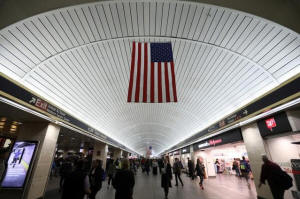|
U.S. cities' revenue growth expected to
contract in 2017: report
 Send a link to a friend
Send a link to a friend
 [September 12, 2017]
By Stephanie Kelly [September 12, 2017]
By Stephanie Kelly
NEW YORK (Reuters) - U.S. cities' revenue
growth in fiscal 2017 is projected to contract for a second consecutive
year, the first time this has happened since the recession, according to
a report released on Tuesday by the National League of Cities.
The report, based on a survey of finance officers from 261 cities, found
that General Fund revenues are slowing. Revenue growth for the fiscal
year ended June 30 is projected to "stagnate" to a rate of 0.9 percent,
down from fiscal 2016's growth rate of 2.61 percent, the survey said.
"This minimal growth projection is a result of slowing revenue growth
overall, a return to higher levels of inflation in 2017 (2.1 percent)
and the typical conservative approach that finance officers take for
revenue estimates," it said.
In 2015 the revenue growth rate was 3.26 percent.
General Fund revenues are made up of revenues from property, sales,
utility and other taxes.

Property tax revenue growth is expected to slow to a rate of 1.6 percent
in fiscal 2017, compared with 4.3 percent last year. Sales and income
tax revenue growth rates are projected to decline in fiscal 2017 by 0.2
percent and by 2.7 percent, respectively.
The shift in the retail sector to online sales from brick-and-mortar
stores has contributed to the decline in sales tax receipts. Local
governments do not gain as much revenue from online sales and therefore
do not benefit from an improving retail sector, the report said.
In addition, declines in income tax revenues can be attributed to
"gradual employment gains and slow wage growth, widening income
inequality and a lack of expansion of middle-income jobs," the report
noted.
[to top of second column] |

People walk though Pennsylvania Station in the Manhattan borough of
New York City, New York, U.S. May 22, 2017. REUTERS/Carlo Allegri

Christiana McFarland, a research director for the NLC, told Reuters
that cities are seeing more pressure from state governments in the
form of less financial funding, as they have budget concerns of
their own.
"Many cities receive aid from their state governments that are part
of this revenue picture," she said.
At the same time, expenditures in fiscal 2017 are expected to
increase by 2.1 percent over 2016, the report said.
It added that fewer city finance officers are confident in the
fiscal position of their cities. The percentage of officers who said
their cities are "better able to meet the financial needs of their
communities in 2017 than in 2016" fell to 69 percent, down from 81
percent in the prior year.
For a graphic on change in U.S. Cities' Constant Dollar Revenue and
Expenditures (General Fund), click: http://reut.rs/2f09Qnj
(Reporting by Stephanie Kelly; Editing by Daniel Bases and Dan
Grebler)
[© 2017 Thomson Reuters. All rights
reserved.]
Copyright 2017 Reuters. All rights reserved. This material may not be published,
broadcast, rewritten or redistributed.

 |